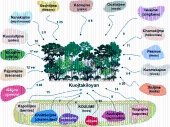posted 12 years ago
Swidden or shifting agriculture (This is not permaculture, in the conventional sense. It is more like a combination of permaculture and crop rotation. Maybe we could call it semi-permaculture?), such as milpa, was practiced throughout tropical America, and can be found throughout the world in both tropical and temperate locations, including here in North America. One major reason swidden has almost disappeared is because of modern land tenure systems. Throughout Latin America, in order to show ownership of a particular property, you must clear it and mark the boundaries. In order to keep your property, under many modern agricultural reform laws, you must actively cultivate all of it or risk having it taken by others or the State. You cannot leave land fallow for twenty or more years, as most swidden systems require. Conversely, forests that are being conserved will not allow swidden agriculture by its historic inhabitants because "slash and burn" is considered evil.
Swidden is ideal for many marginal soils because it allows maximum output of vegetables, grains, fruits, nuts, herbs, game, timber and other non-food forest products. It can support much larger populations through this mixed agricultural/hunter/gatherer system than can be supported through conventional agriculture, monoculture or reverting to climax forest in the same area.
Unfortunately, most of the knowledge needed to successfully practice swidden agriculture in specific areas has been lost, so even if laws and norms can be changed, it could take a few generations to get back into the swing of it.
There are some who claim (and I agree with them) that terra preta is a result of hundreds or even thousands of years of successive swidden rotations. The addition of charcoal (or just "char", for the politically correct) to the soil may improve it and allow longer periods of cultivation or even permanent cultivation, using appropriate methods.
I don't know as you would be able to slash and burn your property in the US without a permit, which may or may not be obtainable. You might, however, be able to pyrolyze your slash, without polluting or risking a wildfire, in portable gasifying kilns, plans for which can be found on the internet. You would then have to distribute the ash and charcoal back onto the land. It would be doable but more labor and capital intensive.
If you have good rich soil, you don't need to use swidden agriculture. Permaculture or organic crop rotation should work fine.






